2014 AUDI RS7 SPORTBACK light
[x] Cancel search: lightPage 146 of 292
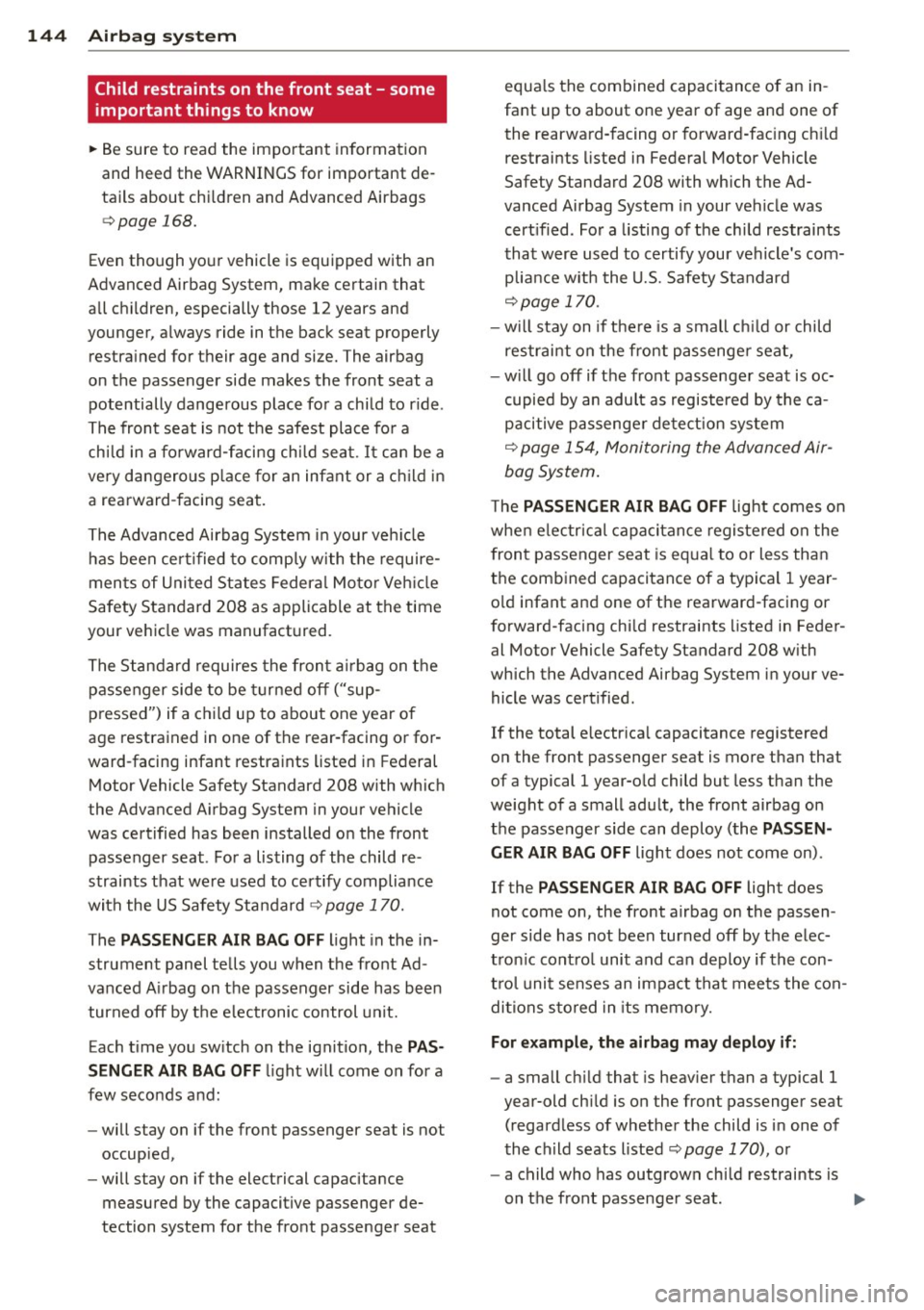
144 Airbag sys tem
Child restraints on the front seat - some
important things to know
• Be sure to read the important information
and heed the WARNINGS for important de
ta ils about ch ildren and Advanced Airbags
i=> page 168.
Even though your vehicle is equipped with an
Advanced Airbag System, make certain that
all children, especially those 12 years and
younger, always ride in the back seat properly
restra ined for their age and size. The airbag
on the passenger side makes the front seat a potentially dangerous place for a child to r ide .
The front seat is not the safest place fo r a
chi ld in a fo rward-facing chi ld seat.
It can be a
ve ry dangerous p lace for an infant or a c hild in
a rearward -facing seat.
The Advanced Airbag System i n your veh icle
has been certified to comply with the require
men ts of United States Federa l Mo to r Veh icle
Safety Standard 208 as applicable at the time
your ve hicle was manufact ured.
The Standa rd requires the fron t air bag on t he
passenger side to be turned off ("sup
p ressed") if a child up to about one yea r of
age restrained in one of the rear-facing or for
ward-facing infant restraints listed in Federal
Motor Vehicle Safety Standard 208 with which
the Advanced A irbag System in your vehicle
was certified has been installed on the front
passenger seat. For a listing of the child re
straints that we re used to certify compliance
with the US Safety Sta ndard
c> page 170.
The PASSENGER AIR BAG OFF light in the in
strument panel tells you when the front Ad
vanced A irbag on the passenger side has been
turned off by t he e lectronic control unit.
Each time you sw itch on the ignit ion, the
PAS
SENGER AIR BAG OFF
l ight will come on for a
few seconds a nd:
- will stay on if the front passenger seat is not
occupied,
- will stay on if the electrical capacitance
measured by the capacitive passenger de
tection system for the fro nt passenger seat equa
ls the combined capacitance of an in
fant up to about one year of age and one of
the rearwa rd-facing or forward-fac ing ch ild
restraints listed in Federal Motor Vehicle
Safety Standard 208 with which the Ad
vanced Airbag System in your vehicle was
cert ified. For a listing of the ch ild restraints
that w ere used to certify you r vehicle 's com
plia nce w it h the U.S. Safety Standard
i=>page 170.
- w ill stay on i f the re is a small c hild or child
restrai nt on the front passenge r seat,
- w ill go off if the front passenger seat is oc
cupied by an adult as registered by the ca pacitive passenge r de tection system
c> page 154, Monitoring the Advanced Air
bag System.
T he PASSENGER AIR BAG OFF light comes on
whe n electr ica l capacitance regis tered on the
front passenger seat is eq ua l to or less than
t h e comb ined capacitance of a typical 1 year
o ld infant and one of the rearward-facing or
forward-facing child restraints listed in Feder
al Motor Vehicle Safety Standard 208 with
which the Advanced Airbag System i n your ve
hicle was cert ified .
If the total e lectr ica l capacitance registered
on the front passenger seat is more than that
of a typical 1 year-old child but less than the
we ight of a small adu lt, the front airbag on
the passenger side can deploy (the
PASSEN
GER AIR BAG OFF
light does not come on).
If the
PASSENGER AIR BAG OFF light does
not come on, the front airbag on the passen
ger side has not been turned off by the e lec
t ron ic cont ro l unit and can deploy if the con
t ro l u nit se nses an impa ct that mee ts the con
di tions s to red in its memory.
For example, the airbag may deploy if:
- a small ch ild that is heav ier th an a typical 1
year-old child is on the front passenger seat
(regard less of whether the child is in one of
the ch ild seats listed
c::;, page 170), o r
- a child who has outgrown child restraints is
on the front passenger seat. ..,.
Page 147 of 292
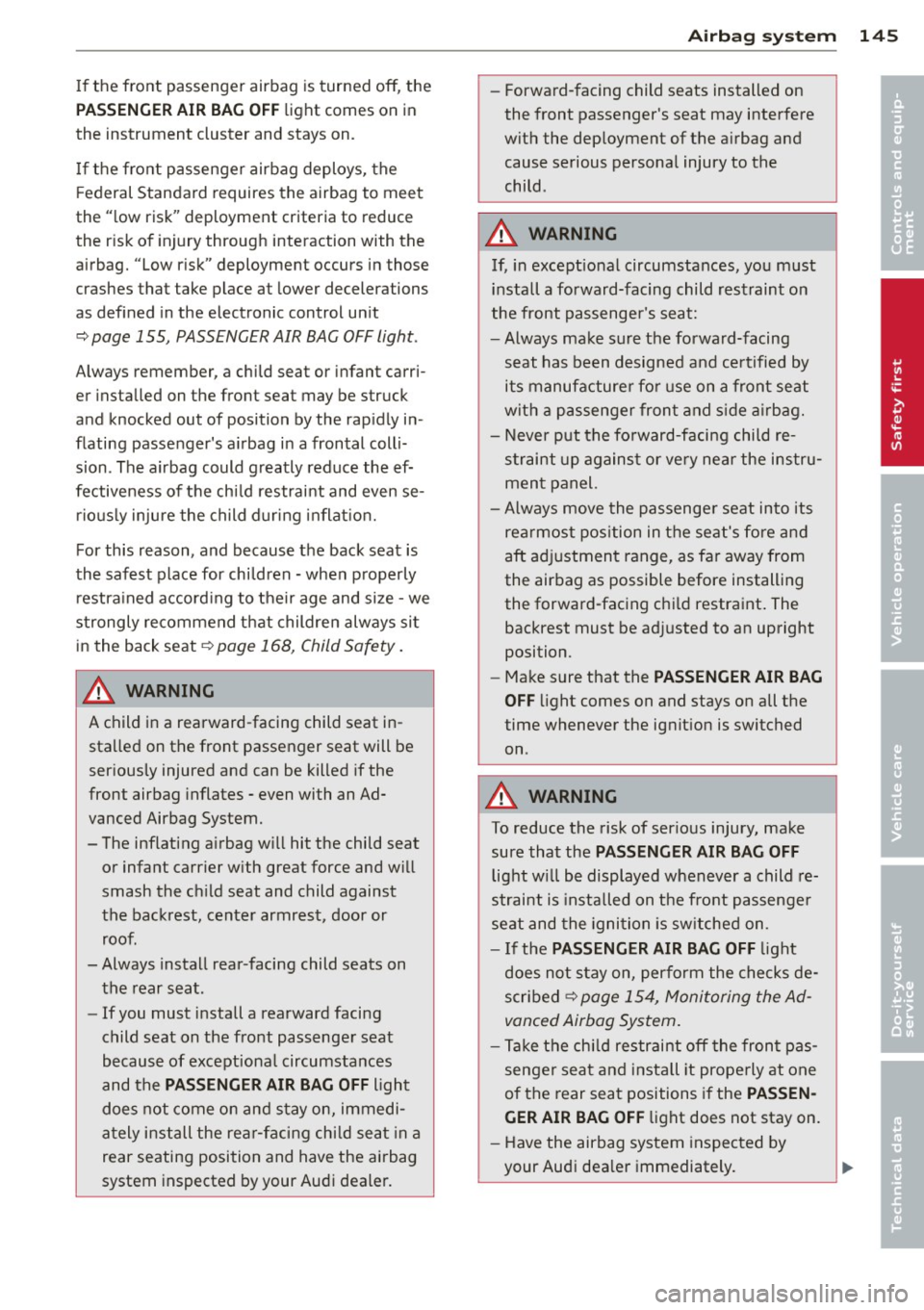
If the fron t passenger airbag is turned off, the
PA SSENGER AIR BA G OF F light comes on in
the instrument cluster and stays on.
If the front passenger airbag deploys, the
F ederal Standard requires the airbag to meet
the " low risk" deployment criteria to reduce
the r isk of injury through interaction with the
airbag. "Low r isk" deployment occurs in those
crashes that take place at lower decelerations
as defined in the electronic control un it
c::> page 155, PASSENGER AIR BAG OFF light.
Always remember, a child seat or infant carri
er installed on the front seat may be struck
and knocked out of position by the rap idly in
flating passenger's a irbag i n a frontal colli
sion . The airbag could greatly reduce the ef
fectiveness of t he ch ild restraint and even se
r io usly inju re the child d uring inflat io n.
For this reason, and because the back seat is
the safest place for chi ldren - when properly
restra ined accord ing to their age and size - we
strongly recommend that children always sit in the back seat
c::> page 168, Child Safety.
A WARNING
-
A child in a rearward -facing child seat in
stalled on the front passenger seat will be
ser iously injured and can be killed if the
front airbag inflates - even with an Ad
vanced Airbag System.
- The inflating airbag w ill hit the child seat
or infant carrier w ith great force and w ill
smash the ch ild seat and child against
the backrest, center armrest, door or roof.
- Always install rear-facing child seats on the rear seat.
- If you must install a rearward facing
child seat on the front passenge r seat
because of exceptiona l circumstances
and the
PASSENGER AIR BAG OFF light
does not come on and stay on, immedi
a tely ins tall the rea r-facing chi ld seat in a
rear seating position and have the airbag
system inspected by your Audi dealer.
A irbag system 145
-Forwa rd-facing child seats installed on
the front passenger's seat may interfere
with the dep loyment of the airbag and
cause serious persona l injury to the
child.
A WARNING
If, in except ional circumstances, you must
install a forward-facing child restraint on
the front passenge r's seat:
- Always ma ke sure the forward-facing
seat has been designed and certified by its manufacture r for use on a front seat
with a passenger fron t and s ide a irbag.
- Never put the fo rward-facing child re
s tra int up against or ve ry near the instru
men t panel.
- Always move the passenge r seat into its
rea rmost pos ition in the se at's fore and
aft ad justment range, as fa r away from
the airbag as possible before installing
the forward-fac ing ch ild restra int . The
backrest must be adj usted to an upright
position.
- Make sure that the
PASSENGER AIR BAG
OFF
li ght comes on and stays on all the
time whenever the ignition is switched on .
A WARNING
To reduce the risk of ser ious injury, make
sure that the
PASSENGER AIR BAG OFF
light w ill be displayed whenever a child re
straint is insta lled on the front passenge r
se at and the ignition is sw itched on.
- If the
PASSENGER AIR BAG OFF light
does not s tay on, perform the checks de
scribed
c::> page 154, Monitoring the Ad
vanced Airbag System.
- T ake the chi ld restraint off t he front pas
senger seat and install it prope rly at one
of the rear seat positions i f the
PASSEN
GER AIR BAG OFF
light does not stay on.
- Have the airbag system inspected by
your Aud i dea ler immediately.
•
•
Page 150 of 292
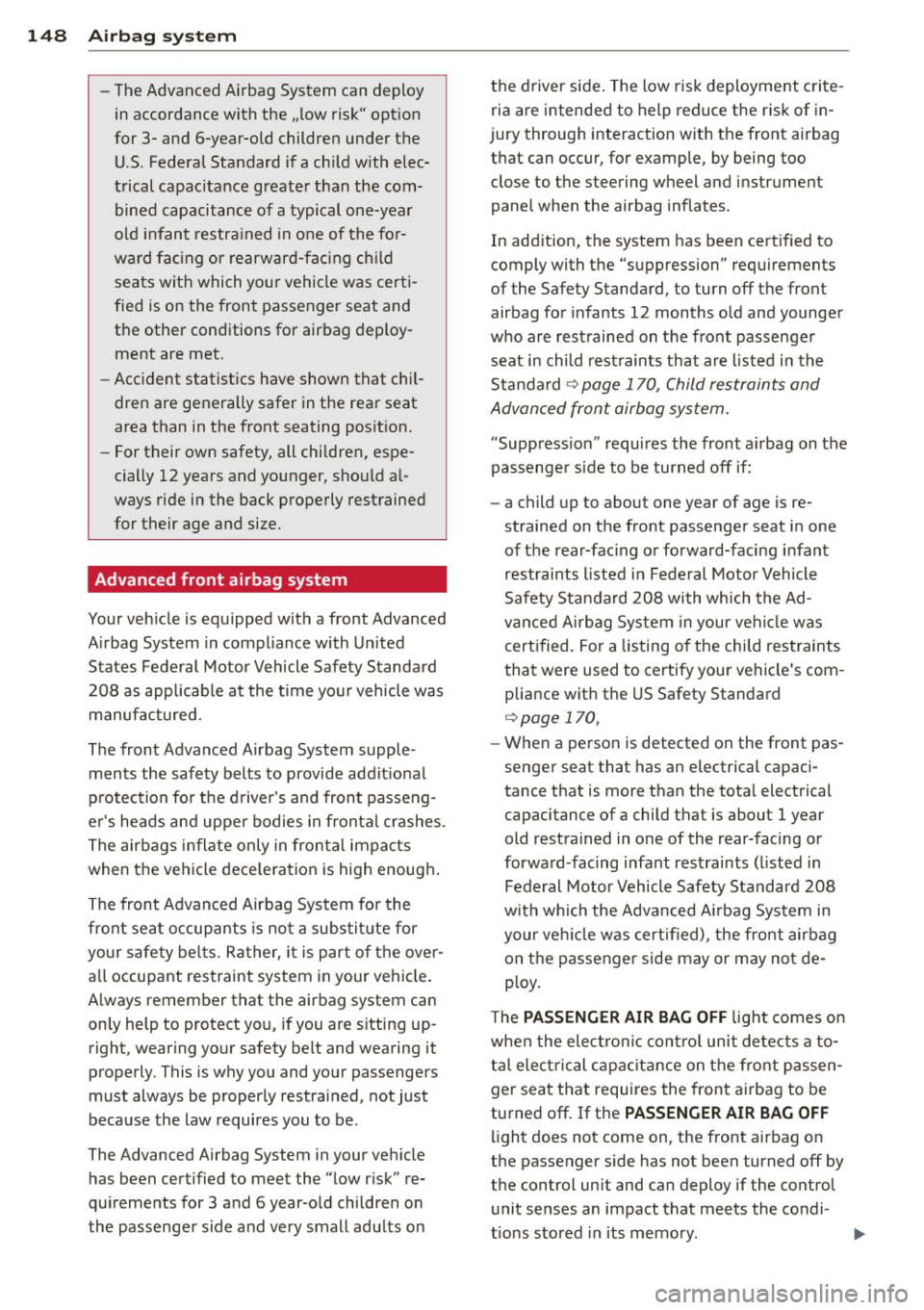
148 Airbag system
-The Advanced Airbag System can deploy
in accordance with the .,low risk" option
for 3- and 6-year-old children under the U.S . Federal Standard if a child with elec
trical capacitance greater than the com bined capacitance of a typical one-year
old infant restrained in one of the for
ward facing or rearward-facing child
seats with which your vehicle was certi
fied is on the front passenger seat and
the other conditions for airbag deploy ment are met.
- Accident statistics have shown that chil
dren are generally safer in the rear seat
area than in the front seating position.
- For their own safety, all children, espe
cially 12 years and younger, should al
ways ride in the back properly restrained
for their age and size.
Advanced front airbag system
Your vehicle is equipped with a front Advanced
Airbag System in compliance with United
States Federal Motor Vehicle Safety Standard
208 as applicable at the time your vehicle was manufactured.
The front Advanced Airbag System supple
ments the safety belts to provide additional
protection for the driver's and front passeng
er's heads and upper bodies in frontal crashes .
The airbags inflate only in frontal impacts
when the vehicle deceleration is high enough.
The front Advanced Airbag System for the
front seat occupants is not a substitute for
your safety belts. Rather, it is part of the over all occupant restraint system in your vehicle.
Always remember that the airbag system can
only help to protect you, if you are sitting up
right, wearing your safety belt and wearing it
properly . This is why you and your passengers
must always be properly restrained, not just
because the law requires you to be.
The Advanced Airbag System in your vehicle has been certified to meet the "low risk" re
quirements for 3 and 6 year-old children on
the passenger side and very small adults on the driver side. The low risk deployment crite
ria are intended to help reduce the risk of in
jury through interaction with the front airbag
that can occur, for example, by being too close to the steering wheel and instrument
panel when the airbag inflates.
In addition, the system has been certified to
comply with the "suppression" requirements
of the Safety Standard, to turn off the front
airbag for infants 12 months old and younger
who are restrained on the front passenger
seat in child restraints that are listed in the
Standard
c::> page 170, Child restraints and
Advanced front airbag system.
"Suppression" requires the front airbag on the
passenger side to be turned off if:
- a child up to about one year of age is re
strained on the front passenger seat in one
of the rear-facing or forward-facing infant
restraints listed in Federal Motor Vehicle
Safety Standard 208 with which the Ad
vanced Airbag System in your vehicle was
certified. For a listing of the child restraints
that were used to certify your vehicle's com
pliance with the US Safety Standard
i=>page 170,
-When a person is detected on the front pas
senger seat that has an electrical capaci
tance that is more than the total electrical
capacitance of a child that is about 1 year
old restrained in one of the rear-facing or
forward -facing infant restraints (listed in
Federal Motor Vehicle Safety Standard 208
with which the Advanced Airbag System in
your vehicle was certified) , the front airbag
on the passenger side may or may not de
ploy.
The
PASSENGER AIR BAG OFF light comes on
when the electronic control unit detects a to
tal electrical capacitance on the front passen ger seat that requires the front airbag to be
turned off. If the
PASSENGER AIR BAG OFF
light does not come on, the front airbag on
the passenger side has not been turned off by
the control unit and can deploy if the control unit senses an impact that meets the condi -
tions stored in its memory. ..,_
Page 151 of 292
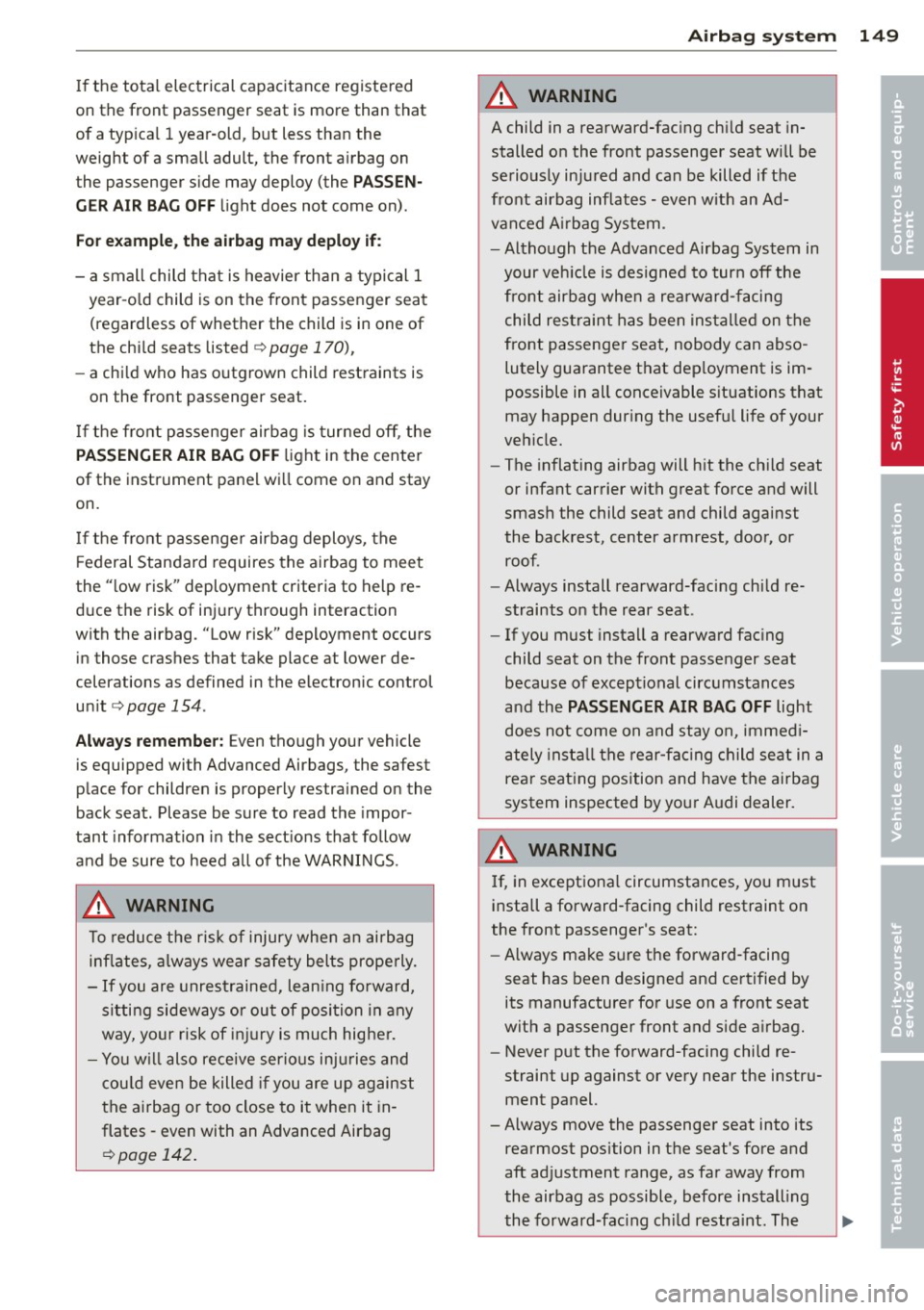
If the total electrical capacitance registered
on the front passenger seat is more than that
of a typ ica l 1 year-old, but less than the
weight of a small adult, the front airbag on the passenger side may deploy (the
PA SSEN
G ER AIR BA G OFF
light does not come on) .
For example, th e air bag m ay depl oy if :
-a small child that is heavier than a typical 1
year-o ld child is on the front passenger seat
(regardless of whether the child is in one of
the chi ld seats listed
¢ page 170),
-a chi ld who has outgrown child restraints is
on the front passenger seat.
I f the front passenger airbag is turned
off, the
PA SSENGER AIR BA G OFF light in the center
of the instrument panel wi ll come on and stay
on.
If the front passenger airbag deploys, the
F ederal Standard requires the a irbag to meet
the " low risk" deployment criteria to help re
d uce the risk of injury through interaction
with the airbag. "Low risk" deployment occurs
in those crashes that take place at lower de
celerations as defined in the electronic control
un it
o page 154 .
Alwa ys rem ember: Even though your vehicle
is equipped with Advanced Airbags, the safest
place for children is properly restrained on the
back seat. Please be sure to read the impor
tant information in the sect ions that follow
and be sure to heed a ll of the WARNINGS.
A WARNING
To reduce the risk of injury when an airbag
inf lates, a lways wear safety belts properly.
- If you are unres trained, lean ing fo rward,
sitting sideways or out of position in any
way, your risk of inj ury is much highe r.
- You w ill also receive serio us inju ries and
cou ld even be killed if you are up against
the a irbag or too close to it when it in
flates -even with an Advanced Airbag
¢ page 142 .
Airbag system 149
A WARNING
A child in a rearward-fac ing ch ild seat in
stalled on the front passenger seat will be
seriously inju red and can be killed if the
front airbag inflates -even w ith an Ad
vanced A irbag System .
- Although the Advanced Airbag System in
your veh icle is designed to turn
off the
front airbag when a rearward-facing child res traint has been installe d on the
front passenger seat, nobody can abso
lutely guarantee that dep loyment is im
possible in all conceivable situations that
may happen dur ing the usefu l life of your
veh icle.
- The inflating airbag will h it the ch ild seat
or infant carrier with great force and will
smash the child seat and child against
the backrest, center armrest, door, or roof.
- Always install rearward-facing chi ld re
straints on the rear seat .
- If you must install a rearward fac ing
child seat on the front passenger seat because of exceptional circumstances
and the
PASSENGER AIR BAG OFF light
does not come on and stay on, immed i
ately in sta ll the rear-fa cing child seat in a
rea r seat ing pos ition and have the airbag
system inspected by your Audi dealer.
A WARNING ,-
If, in except iona l circumstances, you must
install a forward-facing child restraint on
the front passenger's seat:
- Always make sure the forward-facing
seat has been designed and certified by
its manufacturer for use on a front seat
with a passenger front and s ide a irbag.
- Never put the forward-facing child re
straint up against or very near the instru ment panel.
- Always move the passenger seat into its rearmost position in the seat's fore and
aft adjustment range, as far away from
the airbag as possible, before installing
the forward-fac ing ch ild restra int . Th e •
-
•
Page 152 of 292
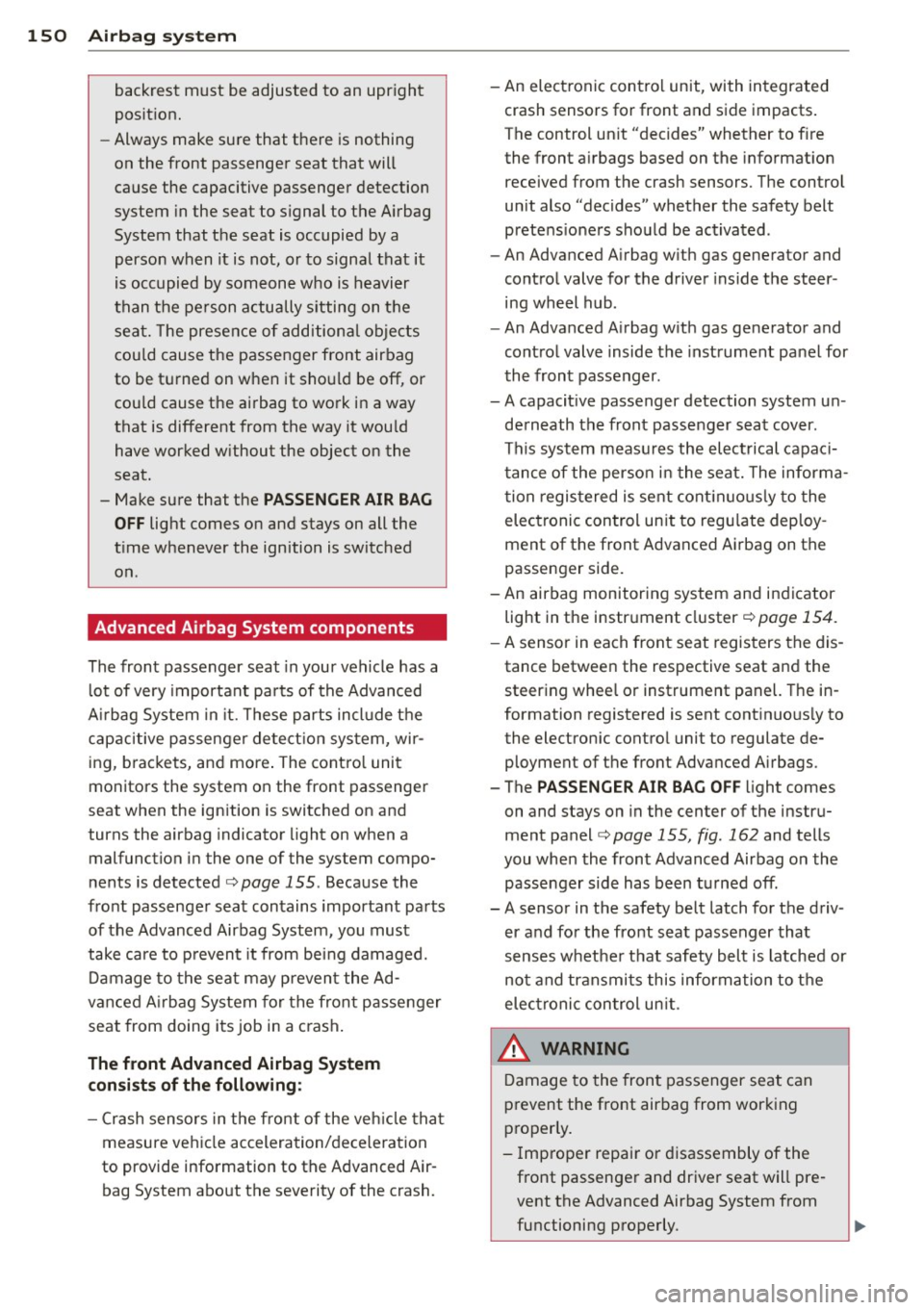
150 Airbag sys te m
backrest must be adjusted to an uprigh t
posit ion.
- Always make sure that there is nothing
on the front passenger seat that will
cause the capacitive passenger detection
system in the seat to s ignal to the A irbag
System that the seat is occupied by a
person when it is not, or to signal that it
is occupied by someone who is heavier
than the pe rson actually s itting on t he
seat. The presence of additiona l objects
cou ld cause the passenger front airbag
to be t urned on w hen it sho uld be off, or
cou ld cause the airbag to work in a way
that is different from the way it wou ld
have worked without the object on the
seat.
- Make sure that the
PASSENGER AIR BA G
OFF
light comes on and stays on all the
t ime w henever the ignition is switched
on.
Advanced Airbag System components
The front passenger seat in you r veh icle has a
l ot of very important pa rts of the Advanced
A irbag System in it . These parts include the
capacitive passenge r de tect ion sys tem, wir
ing, brac kets, and more . The cont ro l uni t
monitors the system on the front passenger
seat when the ignition is switc hed on and
turns the airbag indicato r light on when a
malfunction in the one of the system compo
nents is detected
c::;, page 155 . Because the
fro nt passenge r seat contains important pa rts
of the Advanced Airbag System , you must
take ca re to p revent it from being damaged.
Da mage to the seat may preven t the Ad
vanced A irb ag System for the fron t passenger
seat from doing i ts job in a c rash .
The front Advanced Airbag System
consists of the following:
-Crash sensors in the front o f the veh icle tha t
measure veh icle acceleration/dece le ration
to provide information to the Advanced Air bag System about the severity of the crash. -
An elect ronic contro l unit, with integrated
crash sensors for front and sid e impacts .
T he control un it "decides" whether to fire
the front a irbags based on the inform at ion
received from the crash sensors. The control
unit also "decides" whether the safety belt prete nsioners shou ld be act ivated .
- An Advanced A irbag w ith gas generator and
contro l valve for the driver inside the steer
ing wheel hub .
- An Advanced A irbag w ith gas generator and
contro l valve inside the inst rument panel for
the front passenger .
- A capacit ive passenger detection system u n
de rneath the front passenger seat cover .
This system measures the elec trical capac i
t ance of the perso n in t he seat. The informa
t ion regis tered is se nt cont inuo usly to the
electronic con trol un it to regu late deploy
ment of the front Advanced Airbag on the
passenger side.
- An airbag monitoring system and indicator
light in the instr ument cluster
c::;, page 154.
- A senso r in each front seat regis ters the dis
tance between the respective seat and the
steering whee l or instrument panel. The in
formation registered is sent cont inuo usly to
the electron ic contro l uni t to regulate de
ployment of the front Adv a need A irbags .
- The
PASSENGER AIR BAG OFF light comes
on and stays on in the center of the instr u
ment panel
c::;, page 155, fig . 162 and tells
you when the front Advanced Airbag on the
passenger side has been t urned off.
- A sensor in the safety belt latch for the driv
er and fo r the front seat passenger that
senses w hether t hat safety belt is latched or
no t and transmi ts this information to t he
elec tronic con trol un it.
A WARNING
D amage to the fron t passenger seat can
prevent the front airbag from working
p roperly.
- Imp roper repai r or disassembly of the
front passenge r and dr iver seat will pre
vent the Advanced Airbag System from
functioning properly .
-
Page 153 of 292
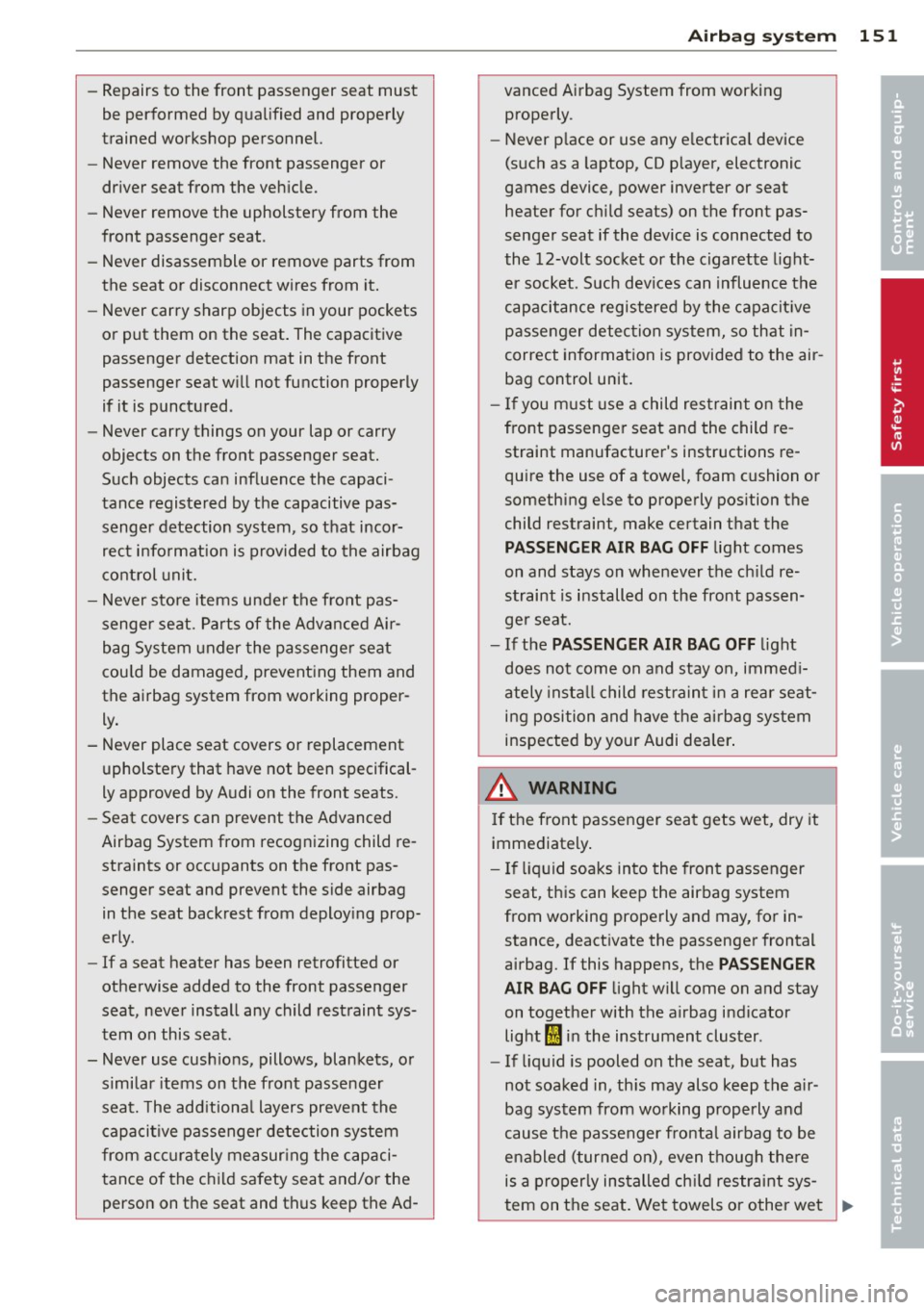
-Repairs to the front passenger seat must
be performed by qualified and properly
trained workshop personnel.
- Never remove the front passenger or
driver seat from the vehicle.
- Never remove the upholstery from the
front passenger seat.
- Never disassemble or remove parts from
the seat or disconnect wires from it.
- Never carry sharp objects in your pockets
or put them on the seat. The capacitive
passenger detection mat in the front
passenger seat will not function properly
if it is punctured .
- Never carry things on your lap or carry
objects on the front passenger seat.
Such objects can influence the capaci
tance registered by the capacitive pas senger detection system, so that incor
rect information is provided to the airbag
control unit.
- Never store items under the front pas
senger seat. Parts of the Advanced Air
bag System under the passenger seat
could be damaged, preventing them and
the airbag system from working proper
ly.
- Never place seat covers or replacement
upholstery that have not been specifical
ly approved by Audi on the front seats.
- Seat covers can prevent the Advanced
Airbag System from recognizing child re
straints or occupants on the front pas
senger seat and prevent the side airbag in the seat backrest from deploying prop
erly .
- If a seat heater has been retrofitted or
otherwise added to the front passenger
seat, never install any child restraint sys
tem on this seat.
- Never use cushions, pillows, blankets, or
similar items on the front passenger
seat. The additional layers prevent the capacitive passenger detection system
from accurately measuring the capaci
tance of the child safety seat and/or the
person on the seat and thus keep the Ad-
Airbag system 151
vanced Airbag System from working
properly .
- Never place or use any electrical device
(such as a laptop, CD player, electronic
games device, power inverter or seat
heater for child seats) on the front pas
senger seat if the device is connected to
the 12-volt socket or the cigarette light er socket. Such devices can influence the
capacitance registered by the capacitive
passenger detection system, so that in
correct information is provided to the air
bag control unit.
- If you must use a child restraint on the
front passenger seat and the child re
straint manufacturer's instructions re
quire the use of a towel, foam cushion or
something else to properly position the
child restraint, make certain that the
PASSENGER AIR BAG OFF light comes
on and stays on whenever the child re
straint is installed on the front passen
ger seat.
- If the
PASSENGER AIR BAG OFF light
does not come on and stay on, immedi
ately install child restraint in a rear seat
ing position and have the airbag system
inspected by your Audi dealer.
_& WARNING ~
If the front passenger seat gets wet, dry it
immediately.
- If liquid soaks into the front passenger
seat, this can keep the airbag system
from working properly and may, for in
stance, deactivate the passenger frontal
airbag. If this happens, the
PASSENGER
AIR BAG OFF
light will come on and stay
on together with the airbag indicator
light
fl in the instrument cluster .
- If liquid is pooled on the seat, but has
not soaked in, this may also keep the air
bag system from working properly and
cause the passenger frontal airbag to be
enabled (turned on), even though there
is a properly installed child restraint sys-
tem on the seat. Wet towels or other wet .,..
•
•
Page 154 of 292
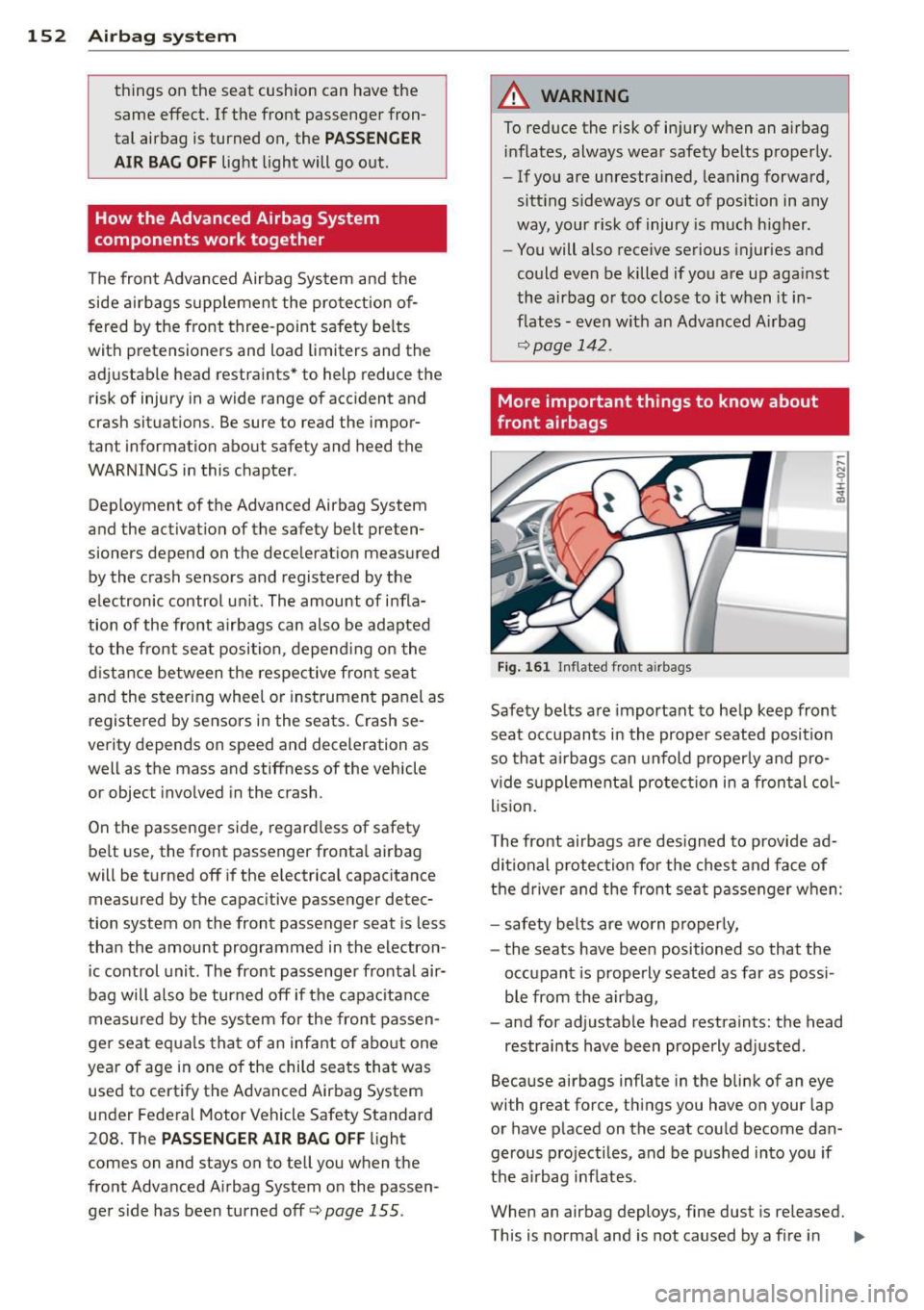
152 Airbag system
things on the sea t cushion can have the
same effect. If the front passenger fron tal airbag is turned on, the
PASSENGER
AIR BAG OFF
light light will go out .
How the Advanced Airbag System
components work together
The front Advanced Airbag System and the
side airbags supplement the protection of
fered by the front three -point safety be lts
with pretensioners and load limiters and the
adj ustab le head restraints* to help reduce the
risk of inju ry in a wide range of accident and
crash situa tions. Be sure to re ad the impor
tan t information abou t safe ty and heed the
WARNINGS in this chapter .
Dep loyment of the Advanced Airbag System
and the activat ion of the safety bel t preten
sioners depend on the decelera tion measured
by the crash sensors and registered by the
e lectronic control un it . The amount of i nfla
tion of the front airbags can also be adapted to the front sea t position , depend ing on the
d istance between t he respective front seat
and the steering wheel o r instrument pa nel as
registered by sensors in the seats. Crash se
ver ity depends on speed and dec elerat ion as
well as the mass and st iffness of the vehicle
or objec t invo lved in the crash .
On the passenge r side, regard less of safety
be lt use, the front passenger fronta l a irbag
will be turned off if the e lectrical capacitance
measured by the capac itive passenger de tec
tion system on the front passenger seat is less
than the amount programmed in the electron
i c co ntrol unit . The front passenger frontal air
bag will a lso be turned off if the capa cita nce
measured by the system for the front passen
ge r seat eq ua ls tha t of an infant of abo ut one
yea r of age in one o f the child sea ts that was
used to cert ify the Advanced Airbag System
under Federal Motor Vehicle Safety Standard
208. The
PASSENGER AIR BAG OFF li ght
comes on and stays on to tell you when the
front Advanced A irbag System on the passen
ge r side has been turned off~
page 155 .
A WARNING
-To reduce the risk of injury w hen an a irbag
in flates, always wear safety be lts p roperly.
- If you are unrestra ined, leaning fo rward,
sitt ing s ideways or out of pos ition in any
way, your risk of injury is much h igher .
- You will a lso receive se rious injuries and
could even be killed if you a re up aga inst
the airbag o r too close to it when it in
flates - even w ith an Advanced A irb ag
r:::> page 1 4 2 .
More important things to know about
front airbags
Fig . 1 61 In flated fro nt a irbags
Safety belts a re important to he lp keep front
seat o ccupants in the proper seated position
so that a irbags can unfold properly and pro
v ide s upplementa l pro te cti on in a fron tal col
li sion .
T he front airbags are des igned to provide ad
di tional p rotection fo r the ches t and face of
the driver a nd the front seat passenger w hen:
- safety belts are worn properly,
- the seats have bee n positioned so that the
occupant is properly seated as far as poss i
b le from the airbag ,
- and for ad justab le head restra ints: the head
restrai nts have been properly ad justed.
Beca use airbags inflate in the blink of an eye
with great force, th ings you have on your lap
or have p laced on the seat cou ld become dan
gerous projecti les, and be p ushed in to you if
t h e a irbag inflates .
When an airbag deploy s, fine dust is re leased.
This is norma l and is not caused by a f ire in ..,.
Page 155 of 292
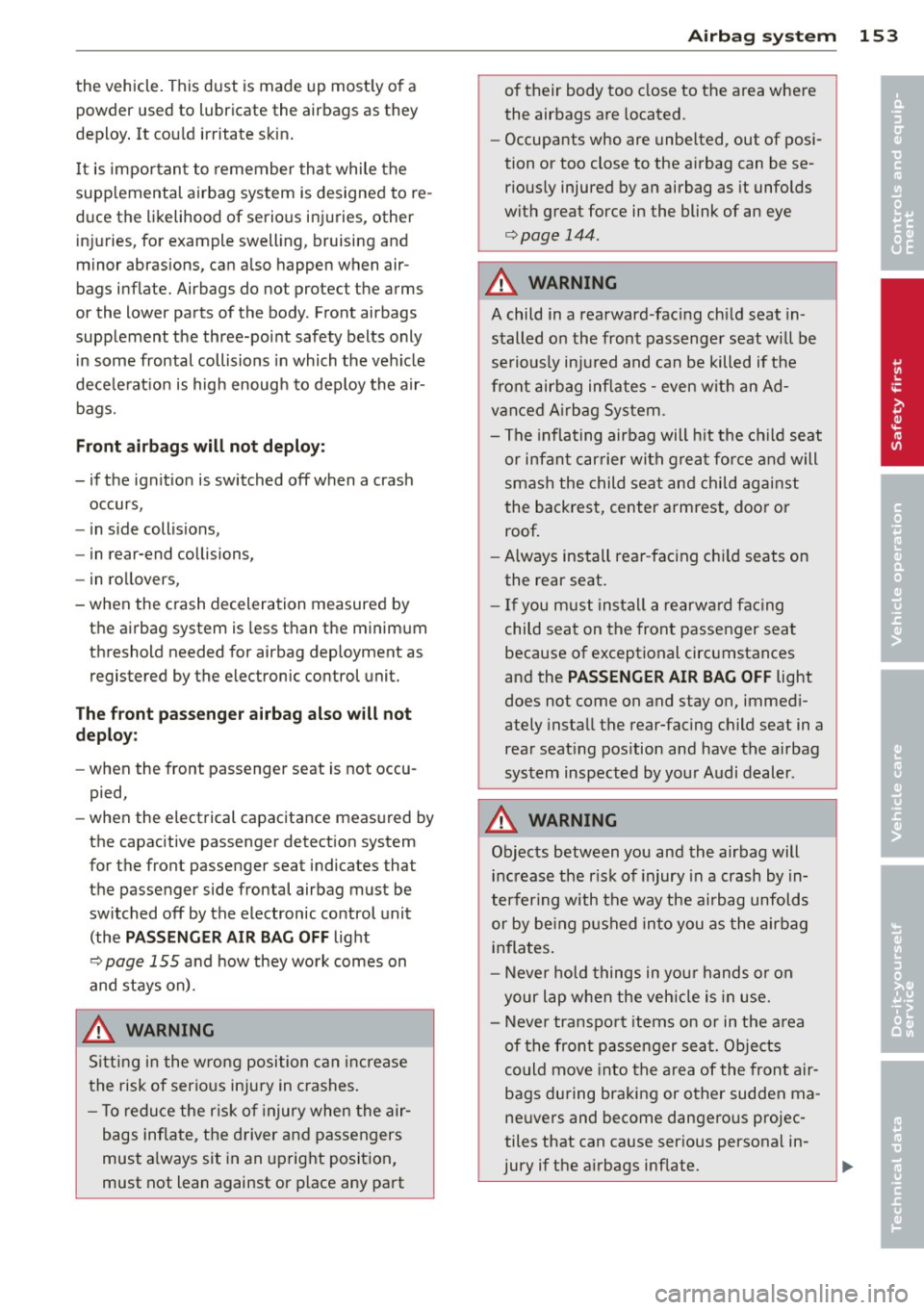
the vehicle. This dust is made up most ly of a
powder used to lubricate the airbags as they
deploy . It cou ld irritate skin .
It is importan t to remember that while the
supplemental airbag system is designed to re
duce the likelihood of serious injuries , other
in ju ries, for example swell ing, bruising and
minor abrasions, can also happen when air
bags inflate. Airbags do not protect the arms
or the lower parts of the body . Front airbags
supplement the three-poi nt safety belts only
i n some frontal collisions in which the vehicle
decelerat ion is high enough to deploy the air
bags.
Front airbags will not deploy:
- if the ignit ion is switched off when a crash
occurs,
- in s ide collisions,
- in rear-end collisions,
- in ro llovers,
- when the crash deceleration measured by
the airbag system is less than the minimum
threshold needed for airbag deployment as
registered by the electronic control unit.
Th e front pa sseng er airbag al so will not
d e plo y:
-when the front passenger seat is not occu
pied,
- when the electrical capacitance measured by
the capacitive passenger detect ion system
for the front passenger seat indicates that
the passenger side frontal airbag must be
switched off by the electronic control unit (the
P ASSENGER AIR BAG OFF light
¢ page 155 and how they wo rk comes on
and stays on).
A WARNING
Sitting in the wrong position can increase
the risk of serious injury in crashes .
- To reduce the r isk o f injury when the air
bags inflate, the driver and passengers
must a lways sit in an upright position,
must not lean against or place any part
A irbag system 153
of their body too close to the area where
the airbags are located.
- Occupants who are unbelted, out of posi
tion or too close to the airbag can be se
riously injured by an airbag as it unfolds
with great force in the blink of an eye
¢page 144.
A WARNING
A child in a rearward-fac ing ch ild seat in
stalled on the front passenger seat will be
se riously injured and can be killed if the
front airbag inflates - even w ith an Ad
vanced A irbag System.
- The inflating airbag will h it the ch ild seat
or infant carrier with great fo rce and will
smash the child seat and child against
the backrest, center armrest, doo r or
roof.
- Always install rear -facing chi ld seats on
the rear seat.
- If you must install a rearward fac ing
child seat on the front passenger seat
because of exceptional circumstances
and the PASS ENG ER AIR BAG OFF light
does not come on and stay on, immed i
ately insta ll the rear-facing child seat in a
rea r seat ing pos ition and have the airbag
system inspected by your Audi dealer .
A WARNING
Objects between you and the airbag will
increase the r isk of injury in a crash by in
terfering with the way the ai rbag unfolds
or by be ing p ushed into you as the airbag
inflates.
- Neve r hold things in yo ur hands o r on
your lap when the veh icle is in use.
- Never transpo rt items on or in the a rea
of the front passenger seat. Objects
co uld move into the area of the front air
bags during braking or other sudden ma
neuvers and become dangero us projec
tiles that can cause ser ious personal in
jury if the a irbags inf late.
•
•
-
-